Virtual Cena y Ciencias Provides Hispanic/Latinx Role Models, Encourages Hands-on “Kitchen Science”—All Done in Spanish
Why does holding your nose when taking medicine help it to not taste so bad? What is surface tension on liquids? What do scientists do in labs? What are crystals and how do they form?
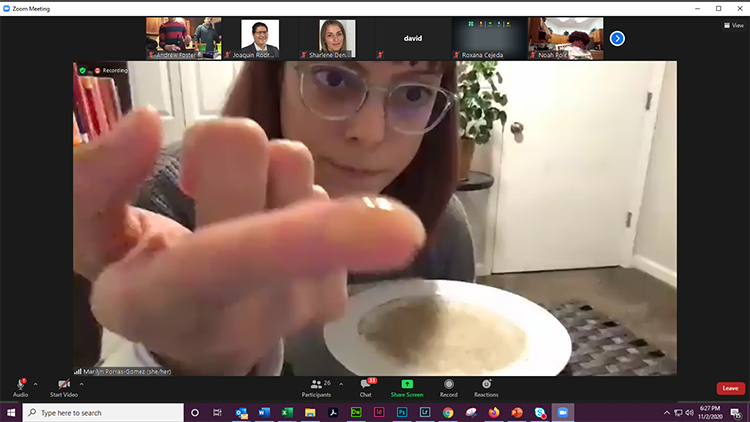
During her November 2nd CyC presentation, Marilyn Porras-Gómez, a third-year Materials Science and Engineering Ph.D. student, shows how pepper sprinkled on water on a plate floats on the top due to surface tension.
November 12, 2020
Noted above are just some of the questions the Virtual Cena y Ciencias (CyC) hopes to answer during its Spanish-language, science outreach events for local Hispanic/Latinx and dual-language-program school children. But, to adhere to COVID-19 social distancing mandates, CyC, scheduled for the first Monday of the month throughout the fall 2020 and spring 2021 semesters, is being held online until further notice. Despite the change of venue, the COVID-19-friendly events, like their no-social-distancing-required predecessors, feature lectures and/or demonstrations followed by hands-on science—with a caveat. The "kitchen science" activities featurescience that can be done with materials available in most homes. Plus, in addition to the exposure to science, the youngsters will experience it in Spanish, offered by Hispanic and Latinx scientists who serve as role models.
Participating in the program are students from Urbana’s Dual Language programs at Dr. Preston Williams Elementary and Leal Elementary schools, as well as Champaign’s International Prep Academy. CyC planners are also seeking to involve middle schoolers who either have been through the program or have younger siblings currently attending. Also involved, mainly in the science and interview parts, are science students from Urbana Middle School.
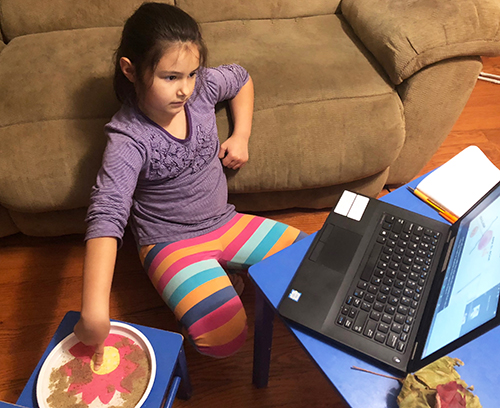
An eight-year-old participating in CyC does the hands-on activity about surface tension on water.
Supporting CyC are a number of partners, including I-MRSEC (the Illinois Materials Research Science and Engineering Center); the state 4-H program; Urbana Unit 116 and Champaign Unit 4 School Districts, along with parents of children in these districts; the Illinois chapter of SACNAS (the Society of the Advancement of Chicanos/Hispanics and Native American Scientists); CPLC (the Center for the Physics of Living Cells); and Grainger College of Engineering. Furthermore, the National Science Foundation (NSF) is providing funding support through the NSF-funded I-MRSEC and CPLC Centers.
A steering committee plans and administrates CyC. Regarding this group, the phrase, “It takes a village,” comes to mind. “I think the model of how the group functions is really important here," claims I-MRSEC Outreach Coordinator Pamela Pena Martin. "Because we have people from the school district, parents, 4H, people from University programs, campus student organizations, etc. working together, this allows us to do several things. School district representation and parents help us to stay in tune to any special considerations and needs of the families we wish to reach. Scientists from campus bring the connection to cutting-edge scientific research. Many identify as Latinx/Hispanic, providing role models for attendees that broaden their perspective of who is a scientist.” As an example of the group’s role, in preparation for leading the November lesson, Marilyn Porras-Gómez, after coming up with possible activities, presented them to the steering committee, so the group could contribute ideas and suggestions for adapting them to the CyC audience.
The 2020 CyC program covers a range of topics that all have some connection to COVID-19 and the related science, with all activities falling under the umbrella of "kitchen science" such that they are easily done at home with common household items. For instance, in October, the lesson focused on one of our five senses: taste. Led by Professor Yanina Pepino, whose research lab looks at individual differences in human taste perception and preferences, and who is a member of an international team studying the impacts of COVID on taste and smell, her lesson’s activities illustrated the importance of smell on how we sense taste.
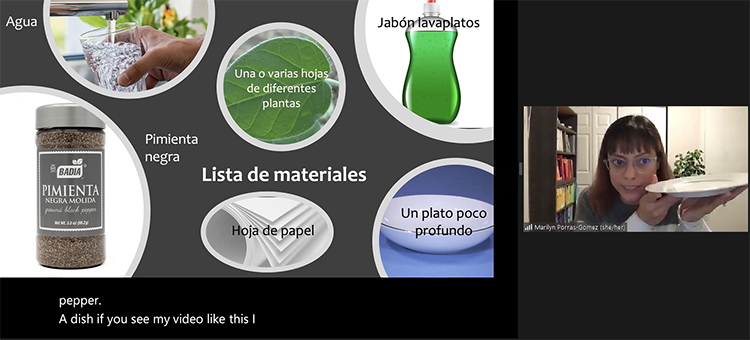
In Marilyn Porras-Gómez's Zoom presentation, she shows students a slide about the various materials they will need in order to do her hands-on activity.
Presenting activities at the November 2nd CyC was Marilyn Porras-Gómez, a third-year Ph.D. student in the Department of Materials Science and Engineering. Somewhat related to her research, the hands-on activity she led was about surface tension “and how soap and our lungs have something in common: they both are capable of reducing the surface tension of liquids,” she explains, adding that she’d planned “a very cool and simple experiment at home to demonstrate how soap does this.”
In addition, Porras-Gómez presented a short 1–2-minute video she’d made called, "Un Día en el Lab" (A Day in the Lab). Entirely in Spanish, the video exposed youngsters to things she might do in her lab on a given day. Geared toward kids, her video included some fast-forwards while she was suiting up in her lab gear and removing it. Plus, a cartoon-esque animated video segment of her in the lab introduced the kids to several procedures she does on a regular basis.
Part of I-MRSEC, Porras-Gómez works in Professor Cecilia Leal's lab, where her research focuses on understanding fundamental properties of lipid membranes (the material cell membranes are mainly made of), in particular, healthy and diseased lung membranes.
Particularly excited about serving as a role model to Hispanic and Latinx youngsters as part of the Cena y Ciencias outreach, Porras-Gómez admits: “Ever since I heard about CyC, I resonated with the cause; therefore, as soon as I became part of the I-MRSEC at the beginning of this year, I let Pam know that I wanted to contribute.” The native Spanish speaker from Costa Rica found the experience quite rewarding.
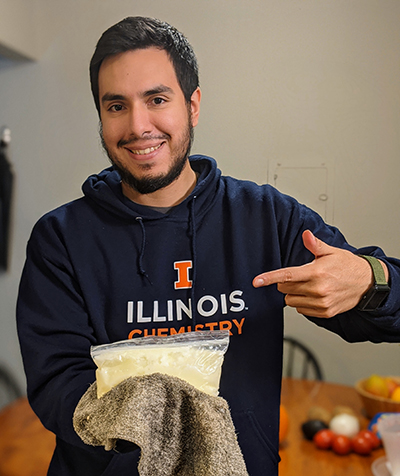
Post doc researcher Gonzalo Campillo-Alvarado with a hands-on activity, "Crystallization of Flavored Milk," from the December CyC's Cristales Escondidos en tu Cocina (Hidden Crystals in your Kitchen).
“I am very passionate about Science and Outreach,” she continues. “I believe that encouragement, representation, and role models are essential tools to bridge the gap of untapped minorities in STEM, and that is what CyC does—making science accessible to Hispanic and Latinx children in the community.”
As the title suggests, the December lesson, Cristales Escondidos en tu Cocina (Hidden Crystals in your Kitchen), which will be led by Gonzalo Campillo-Alvarado, will seek to unveil many of the crystals that we use in our kitchen (sugar and salt, perhaps?). Plus, he intends to discuss how crystals grow and their applications in our world, including their important role in the fight against COVID-19. Two activities he has planned are to "show the properties of chocolate (some of them faster than others) and how we can freeze molecules and create seeds for ice cream formation." Campillo-Alvarado is an I-MRSEC postdoctoral researcher in Professor Ying Diao’s research group in Chemical and Biomolecular Engineering.
Integral to the success of CyC is a lengthy list of committed folks who regularly attend weekly planning meetings or contribute toward the mission of the group in other ways. These include: Ricardo Diaz: 4H, parent; Joaquín Rodríguez López: University; Rachel Whitaker: University; Sharlene Denos: University, parent, Champaign International Prep Academy PTA; Luisana Hernandez: Urbana School District, parent; Amy Leman: University, evaluation and assessments; Andrea Marroquin: Urbana School District; Luis de Jesus Astacio: University, SACNAS; Mitzy Castillo Maldonado: Urbana School District; Pam Pena Martin: University, parent; Felipe Menanteau: University, parent; Roxana Cejeda: University, 4H; Marilyn Porras-Gómez: University; Gonzalo Campillo Alvarado: University; William Hernandez: University, SACNAS; Vanessa Blas: University, SACNAS; Victor Cervantes: University, Grainger College of Engineering.
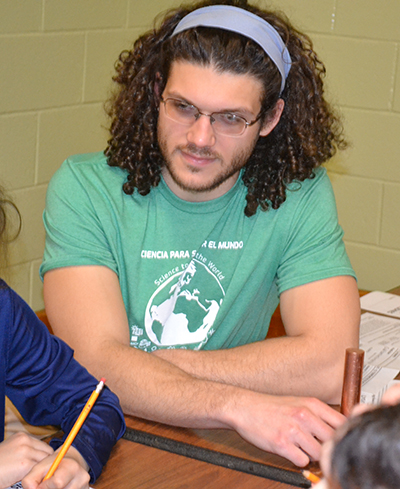
Illinois grad student Luis M. de Jesus Astacio works with youngsters during a February 2020 Cena y Ciencias at Dr. Preston Williams School.
So why did all of these folks get involved with CyC? What do they personally find rewarding about it? What kind of impact do they believe CyC is having on youngsters? Several of the folks above share what CyC means to them personally and how they believe it’s impacting the kids/families who are participating.
For example, Illinois grad student Luis M. de Jesus Astacio, who has lived in Puerto Rico most of his life, reports: “I wasn’t aware of the unproportionally low presence of Latinxs and Hispanics in STEM until I moved to Illinois for graduate school. Back home, my commitment towards inclusivity in academia sometimes involved participating in initiatives similar to CyC.” So, once he arrived in Urbana, he joined CyC, explaining that “It seemed to me as one of the most direct and impactful ways to help alleviate the socio-economic disparity in STEM across the USA.”
In terms of the impact CyC is having on the youngsters, Luisana Hernandez, an Urbana School District parent, states: “Cena y Ciencias has a great impact on students! As a parent, I enjoy listening to my kids talk about the activities as they apply them in different scenarios. In October, we had a lesson on taste, and since then, my children continue to test the experiment, especially with medicine!”
Mitzy Castillo Maldonado of the Urbana School District recalls that when she was in elementary school, she was invited to participate in an after-school science program run by Illinois students. “It was such an amazing and unique experience that my fellow ESL students and I would not have had if not for the University,” she recollects. “I believe this is the same for the current students that now participate in CyC, especially those who are recent arrivals and are still learning English.”
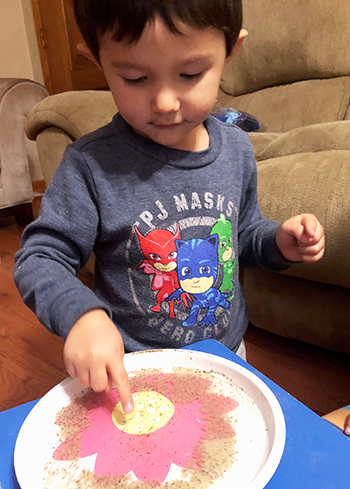
A local three-year-old participates in the surface tension hands-on activity during the November 2nd CyC.
Andrea Marroquin from the Urbana School District, who has served as a TA at Leal for the past several years, reports hearing conversations students were having about Cena y Ciencias. “They would be so excited to attend the event!” she exclaims, saying things like “‘I wonder what we will be doing tonight?’ and ‘The pizza is so good!’ She then goes on to cite several positive impacts of the program: “Even just them being excited to be around their peers, and learning from the U of I students, and learning from experience, and seeing ‘young’ kids with this knowledgeable background on science—it showed them how attainable science really is.”
In addition, the fact that C&C is presented in Spanish, largely by folks of Hispanic and Latinx origin, is quite important to those who are integrally involved. According to Ricardo Diaz from 4H, who is also a parent, “Parents, volunteers, and presenters serve as models in both language and career. Spanish thus becomes a viable language for career and communication.”
Grad student Luis M. de Jesus Astacio indicates that, “By presenting the science lessons and demos in Spanish, we are showing the kids that science is a field accessible to all members of society. Similarly, by hearing these lessons from other Hispanics, we are setting an example for them.” About whether he considers CyC’s main goal to be teaching the kids science or showing them that they too can be scientists, de Jesus Astacio adds, “As scientists, we think that scientific literacy is important and necessary. However, at the end of the day, what we are after is for the kids to allow themselves to dream and to pursue such dreams. This is especially important when societal pressures tend to tell otherwise.”
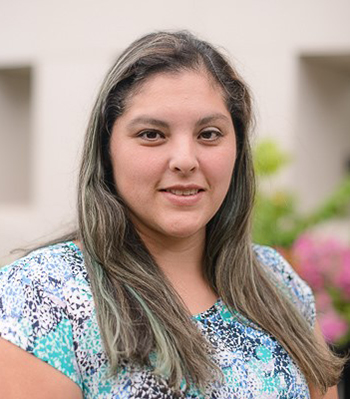
Urbana School District's Luisana Hernandez.
Vis-à-vis CyC’s Spanish language component, Luisana Hernandez reports asking her children, “Who can be a scientist?” and being taken aback when they replied, “Anyone!” “Their answer surprised me,” she admits, “but I know that it wouldn't have been the same answer if they didn’t participate in CyC. We live in a community with many learning opportunities, but rarely are any in Spanish. The opportunity of my kids participating in CyC in Spanish gives them a chance to identify themselves with the language, students, and scientists.”
Citing a further benefit of CyC, another participant says, “Building community connections with the University of Illinois has ongoing impact even beyond the specific goals of CyC.”
In hopes that others doing outreach in our social-distancing new normal might find it useful, Pamela Pena Martin shares a bit about how CyC adapted to the virtual world after knowing in the summer that it wouldn’t be possible to run CyC in its typical format.
“We have been able to maintain much of what makes the CyC program special, and more importantly, effective,” she acknowledges. “We still encourage the whole family to participate in the lesson. We still present great science, with content led by scientists at the leading edge of their respective fields, many who also serve as role models through shared identities with kids attending. Kids are still being introduced to these science concepts and activities entirely in Spanish. The aim is still for activities to be fun—that students would enjoy it and ‘learn by doing.’ With the first lesson, we could already see how engaged many kids were by the great questions they asked during the session.”
Despite the glowing assessment, Pena Martin admits that they a have faced a few difficulties related to the virtual format. For one, while they have funds to purchase materials for activities, safely distributing those has proved challenging. Thus, for hands-on activities, they rely on common household items, the key word being “common” and easily accessible for everyone. She acknowledges that having school district representatives who know the families really helps.
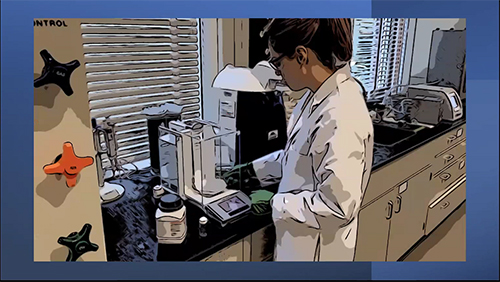
Marilyn Porras-Gómez in the animated video segment that was part of her "Un Día en el Lab" video, which shows her doing various activities in her lab.
To describe another challenge they have encountered, Pena Martin coins a new COVID-19-related phrase—“Zoom fatigue!” “Kids are doing much of their learning via screens as it is,” she admits, “so we keep lessons to less than an hour, a bit shorter than the normal in-person lesson.”
Another really important challenge they haven’t figured out how to address? They haven’t yet found a way to provide the “Cena” (normally pizza) part of Cena y Ciencias (Spanish for Supper and Science.)
Finally, Pena Martin reports that they had to adapt between the first and second lesson, adjusting content to make more time for questions. “Participation was higher than anticipated—a good thing!” she explains. Plus, they added English subtitles “which PowerPoint can do reasonably well from spoken Spanish,” she claims, in order to help Spanish-learners follow in a space where audio interruptions can leave them struggling more than in the in-person program.
Story and photos by Elizabeth Innes, Communications Specialist, I-STEM Education Initiative
More: Cena y Ciencias, I-MRSEC, K-6 Outreach, SACNAS, Underserved Minorities, 2020
For other I-STEM articles about Cena y Ciencias, see:
- Cena y Ciencias—Science Demonstrated in Spanish by Hispanic Role Models
- Cena Y Ciencias Exposes Hispanic Elementary School Students to Materials Science at MRL
- Polímeros! Cena y Ciencias Program Teaches About Materials Through a Supper & Science Night
- Leal Science Night Exposes Local Youngsters to STEM, Role Models
- Cena Y Ciencias: Supper and Science…and Role Models, Courtesy of SACNAS
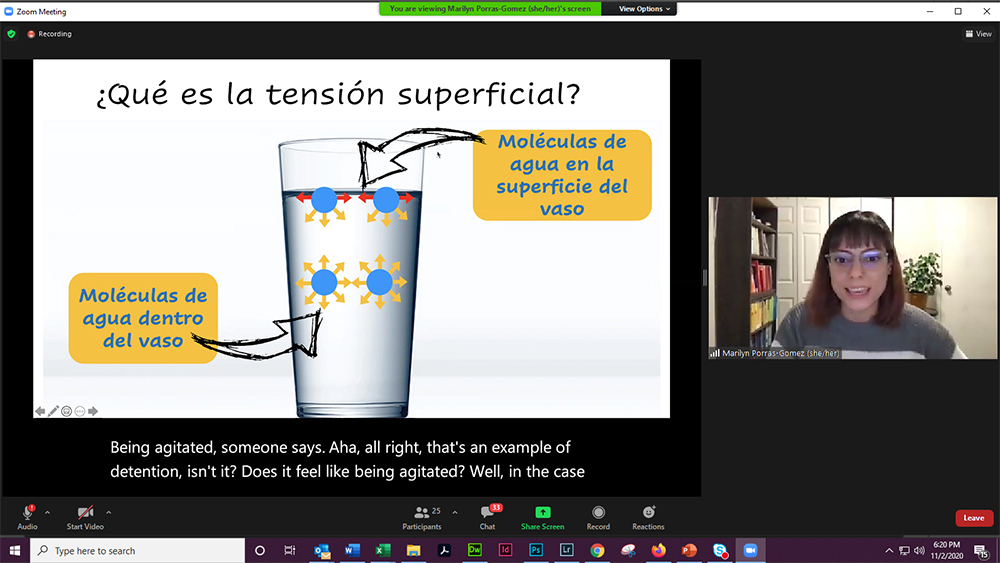 Marilyn Porras-Gómez presents a slide about surface tension during her Zoom presentation.
Marilyn Porras-Gómez presents a slide about surface tension during her Zoom presentation.













.jpg)
















